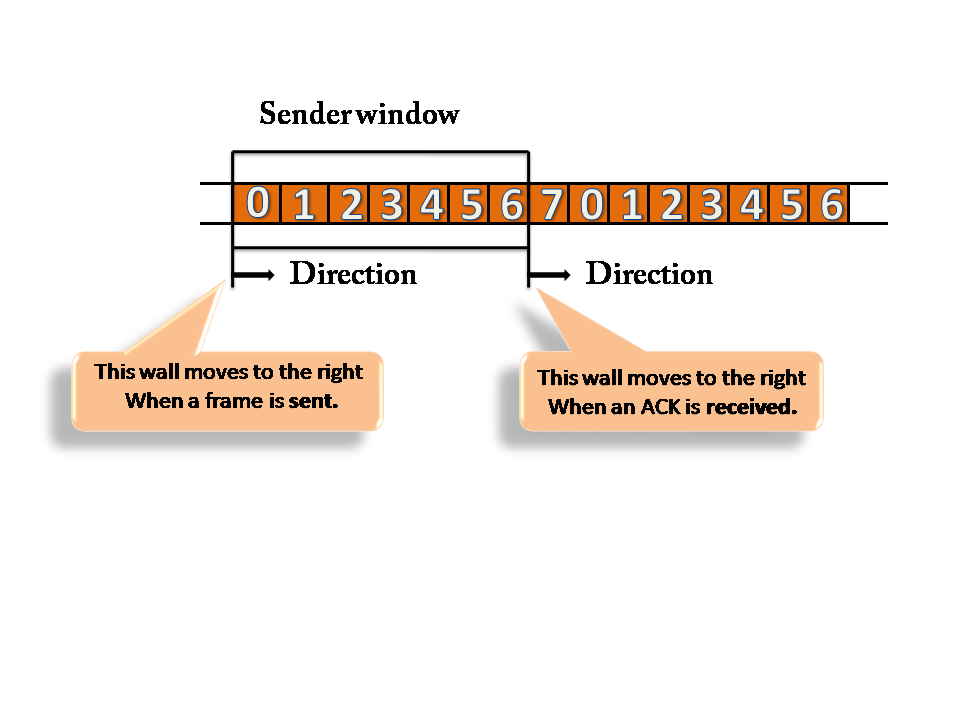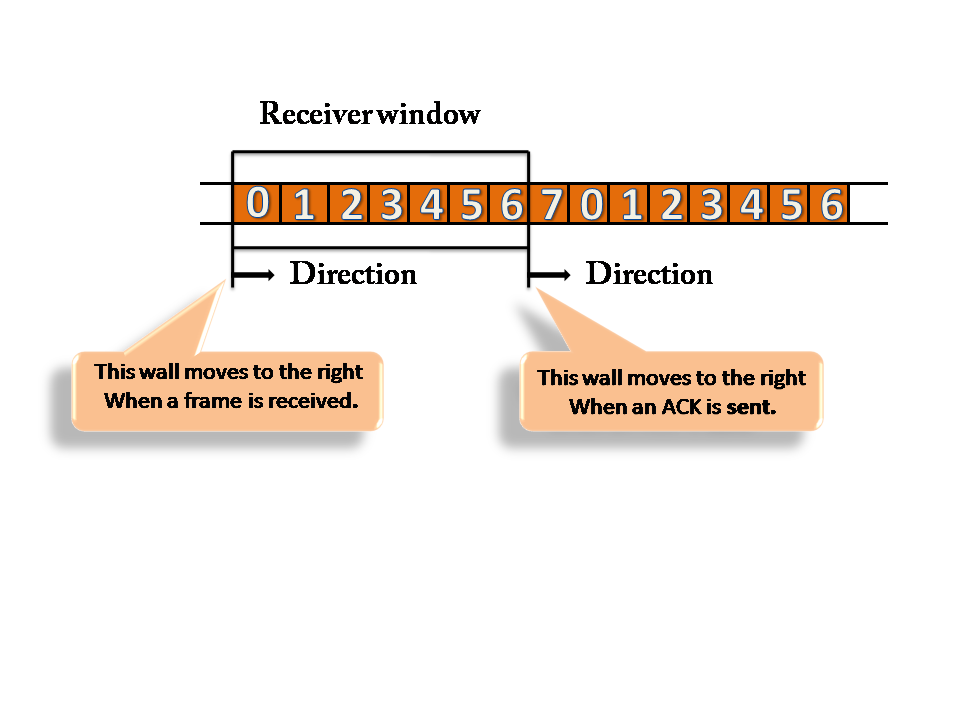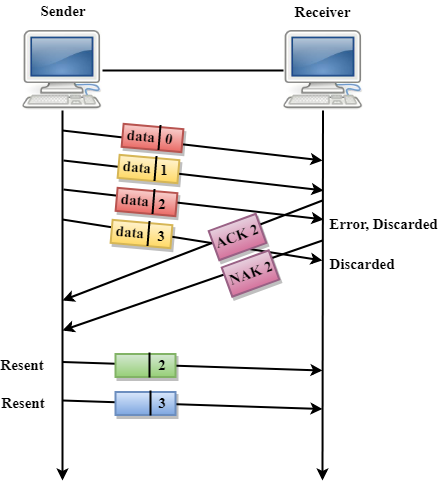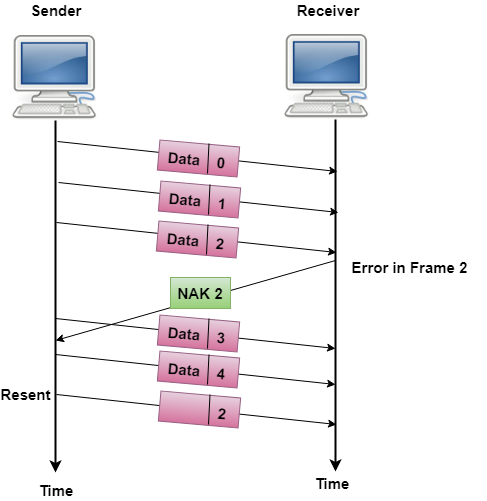- At the beginning of a transmission, the sender window contains n-1 frames, and when they are sent out, the left boundary moves inward shrinking the size of the window. For example, if the size of the window is w if three frames are sent out, then the number of frames left out in the sender window is w-3.
- Once the ACK has arrived, then the sender window expands to the number which will be equal to the number of frames acknowledged by ACK.
- For example, the size of the window is 7, and if frames 0 through 4 have been sent out and no acknowledgement has arrived, then the sender window contains only two frames, i.e., 5 and 6. Now, if ACK has arrived with a number 4 which means that 0 through 3 frames have arrived undamaged and the sender window is expanded to include the next four frames. Therefore, the sender window contains six frames (5,6,7,0,1,2).

Receiver Window
- At the beginning of transmission, the receiver window does not contain n frames, but it contains n-1 spaces for frames.
- When the new frame arrives, the size of the window shrinks.
- The receiver window does not represent the number of frames received, but it represents the number of frames that can be received before an ACK is sent. For example, the size of the window is w, if three frames are received then the number of spaces available in the window is (w-3).
- Once the acknowledgement is sent, the receiver window expands by the number equal to the number of frames acknowledged.
- Suppose the size of the window is 7 means that the receiver window contains seven spaces for seven frames. If the one frame is received, then the receiver window shrinks and moving the boundary from 0 to 1. In this way, window shrinks one by one, so window now contains the six spaces. If frames from 0 through 4 have sent, then the window contains two spaces before an acknowledgement is sent.

Error Control
Error Control is a technique of error detection and retransmission.
Categories of Error Control:

Stop-and-wait ARQ
Stop-and-wait ARQ is a technique used to retransmit the data in case of damaged or lost frames.
This technique works on the principle that the sender will not transmit the next frame until it receives the acknowledgement of the last transmitted frame.
Four features are required for the retransmission:
- The sending device keeps a copy of the last transmitted frame until the acknowledgement is received. Keeping the copy allows the sender to retransmit the data if the frame is not received correctly.
- Both the data frames and the ACK frames are numbered alternately 0 and 1 so that they can be identified individually. Suppose data 1 frame acknowledges the data 0 frame means that the data 0 frame has been arrived correctly and expects to receive data 1 frame.
- If an error occurs in the last transmitted frame, then the receiver sends the NAK frame which is not numbered. On receiving the NAK frame, sender retransmits the data.
- It works with the timer. If the acknowledgement is not received within the allotted time, then the sender assumes that the frame is lost during the transmission, so it will retransmit the frame.
Two possibilities of the retransmission:
- Damaged Frame: When the receiver receives a damaged frame, i.e., the frame contains an error, then it returns the NAK frame. For example, when the data 0 frame is sent, and then the receiver sends the ACK 1 frame means that the data 0 has arrived correctly, and transmits the data 1 frame. The sender transmits the next frame: data 1. It reaches undamaged, and the receiver returns ACK 0. The sender transmits the next frame: data 0. The receiver reports an error and returns the NAK frame. The sender retransmits the data 0 frame.
- Lost Frame: Sender is equipped with the timer and starts when the frame is transmitted. Sometimes the frame has not arrived at the receiving end so that it can be acknowledged neither positively nor negatively. The sender waits for acknowledgement until the timer goes off. If the timer goes off, it retransmits the last transmitted frame.
Sliding Window ARQ
SlidingWindow ARQ is a technique used for continuous transmission error control.
Three Features used for retransmission:
- In this case, the sender keeps the copies of all the transmitted frames until they have been acknowledged. Suppose the frames from 0 through 4 have been transmitted, and the last acknowledgement was for frame 2, the sender has to keep the copies of frames 3 and 4 until they receive correctly.
- The receiver can send either NAK or ACK depending on the conditions. The NAK frame tells the sender that the data have been received damaged. Since the sliding window is a continuous transmission mechanism, both ACK and NAK must be numbered for the identification of a frame. The ACK frame consists of a number that represents the next frame which the receiver expects to receive. The NAK frame consists of a number that represents the damaged frame.
- The sliding window ARQ is equipped with the timer to handle the lost acknowledgements. Suppose then n-1 frames have been sent before receiving any acknowledgement. The sender waits for the acknowledgement, so it starts the timer and waits before sending any more. If the allotted time runs out, the sender retransmits one or all the frames depending upon the protocol used.
Two protocols used in sliding window ARQ:
- Go-Back-n ARQ: In Go-Back-N ARQ protocol, if one frame is lost or damaged, then it retransmits all the frames after which it does not receive the positive ACK.
Three possibilities can occur for retransmission:
- Damaged Frame: When the frame is damaged, then the receiver sends a NAK frame.

In the above figure, three frames have been transmitted before an error discovered in the third frame. In this case, ACK 2 has been returned telling that the frames 0,1 have been received successfully without any error. The receiver discovers the error in data 2 frame, so it returns the NAK 2 frame. The frame 3 is also discarded as it is transmitted after the damaged frame. Therefore, the sender retransmits the frames 2,3.
- Lost Data Frame: In Sliding window protocols, data frames are sent sequentially. If any of the frames is lost, then the next frame arrive at the receiver is out of sequence. The receiver checks the sequence number of each of the frame, discovers the frame that has been skipped, and returns the NAK for the missing frame. The sending device retransmits the frame indicated by NAK as well as the frames transmitted after the lost frame.
- Lost Acknowledgement: The sender can send as many frames as the windows allow before waiting for any acknowledgement. Once the limit of the window is reached, the sender has no more frames to send; it must wait for the acknowledgement. If the acknowledgement is lost, then the sender could wait forever. To avoid such situation, the sender is equipped with the timer that starts counting whenever the window capacity is reached. If the acknowledgement has not been received within the time limit, then the sender retransmits the frame since the last ACK.
Selective-Reject ARQ
- Selective-Reject ARQ technique is more efficient than Go-Back-n ARQ.
- In this technique, only those frames are retransmitted for which negative acknowledgement (NAK) has been received.
- The receiver storage buffer keeps all the damaged frames on hold until the frame in error is correctly received.
- The receiver must have an appropriate logic for reinserting the frames in a correct order.
- The sender must consist of a searching mechanism that selects only the requested frame for retransmission.

No comments:
Post a Comment